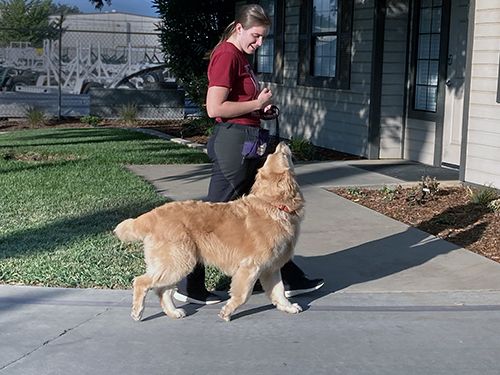If you love playing tug with your dog, you know how fun and bonding it can be. But sometimes, the game gets too rough or your dog won’t let go when you ask.
What if you could teach your dog to play politely and release the toy on command every time? That’s where the automatic release comes in. You’ll learn simple, clear steps to teach polite tug game rules using an automatic release.
Imagine a tug game where you stay in control, your dog listens eagerly, and both of you enjoy every moment without any stress. Keep reading, and you’ll discover how to make that happen—quickly and easily.

Credit: www.amazon.com
Benefits Of Polite Tug Games
Polite tug gameshelp build a strong bondbetween dogs and humans. They teach dogs to play nicely and listento commands. This makes playtime fun and safe for everyone.
Such games encourage controlled play. Dogs learn to grab and release the toy on cue. This stops rough behavior and keeps the dog calm.
Playing tug politely also boosts obedience skills. Dogs practice following rules like “take it” and “drop it.” These commands help dogs behave better in many situations.
Choosing The Right Tug Toy
Choosing a tug toy with the right materialis key. Look for toys made from strong fabricslike cotton or rubber. These materials last longer and handle tuggingwell. Avoid toys that tear easily to keep play safe and fun.
Size matters too. Pick a toy that fits your dog’s mouthcomfortably. A toy too small can be swallowed. Too big, and your dog may struggle to hold it. Good griphelps your dog pull without slipping. Look for toys with handles or textured surfaces for easy holding.
Introducing The Automatic Release
The automatic release devicehelps teach dogs polite tug play. It stops the tug toy from moving until the dog lets go. This teaches the dog to release the toy on command. The device works by holding the toy tight. When the dog releases, it lets the toy move again.
Setting up the device is simple. Attach it to the tug toy first. Then connect the device to a stable object. Make sure it is at the dog’s height. This helps the dog learn better. The device should be easy for the dog to reach but not too loose. Adjust the tension so it holds the toy but can release quickly.
Step-by-step Training Process
Start by teaching your dog to grab the tug toy gently. Use a soft toy for the first sessions. Encourage your dog to hold the toy, then praise with calm words. Avoid pulling too hard to keep play fun.
Next, add a clear release command like “drop” or “give.” Say the command firmly and wait for your dog to let go. Reward immediately with a treat or praise. Repeat this step often to build good habits.
Practice the release at different times during play. Timing is key. Always ask for the release before giving the toy back. This helps your dog learn control and respect for the rules.
Common Challenges And Solutions
Overexcitementoften makes dogs pull too hard during tug. Keep calm and use a soft voice. Stop the game if your dog gets too wild. Let your dog rest before playing again. This helps keep the game fun and safe.
Teach your dog to release quicklyby using a clear command. Praise your dog right after they let go. Use treats to reward fast releases. Practice short sessions to keep your dog’s attention.
| Problem | Solution |
|---|---|
| Overexcitement | Stay calm, stop game if needed, give rest breaks |
| Slow release | Use clear command, praise, and treats for fast letting go |
| Tugging aggression | Stop play if growling, teach gentle play, reward good behavior |

Credit: www.amazon.com
Reinforcing Good Behavior
Positive reinforcementhelps dogs learn polite tug rules quickly. Reward your dog with treats or praise when they follow the automatic release command. This encourages good behavior and makes the game fun for both of you.
Start with short play sessions. Keep tug games brief at first, then slowly increase the duration. This helps your dog stay focused and patient. Stop the game if your dog gets too excited or rough. Calm, steady play teaches control.
| Step | Action | Why it Helps |
|---|---|---|
| 1 | Reward polite release with treats | Encourages good behavior |
| 2 | Keep initial games short | Helps maintain attention |
| 3 | Slowly increase tug duration | Builds patience and control |
| 4 | Stop if dog gets too excited | Prevents rough play |
Safety Tips During Tug Play
Check your dog’s teeth and jawoften during tug play. Tugging can strain teeth and jaw muscles. Stop play if your dog shows signs of pain or discomfort. Keep tug sessions short and gentle to avoid injury. Use toys designed for tugging to protect teeth.
Create a safe play areafree from sharp objects or slippery floors. This helps prevent accidents. Make sure the space is quiet and calm to keep your dog focused. Avoid tugging near furniture or stairs to reduce risks. Always supervise your dog during play to ensure safety.

Credit: www.whole-dog-journal.com
Frequently Asked Questions
What Is An Automatic Release In Polite Tug Games?
An automatic release is a trained behavior where dogs let go of the toy on cue. It ensures controlled play and prevents aggression during tug games. This method promotes polite interactions and helps dogs learn self-control while having fun.
How To Teach Dogs Polite Tug Game Rules?
Start by teaching your dog to release the toy on command. Use positive reinforcement and consistent cues. Keep sessions short and fun. Reward your dog for polite behavior and stopping when asked. This builds trust and improves obedience during tug games.
Why Is Polite Tug Game Training Important?
Polite tug game training prevents biting and aggressive behavior. It strengthens your bond and provides mental stimulation. Training teaches dogs boundaries and respect during play. This ensures safe and enjoyable interaction between you and your dog.
How Long Does It Take To Train Automatic Release?
Training an automatic release usually takes a few weeks. Consistency and patience are key for success. Daily short sessions help dogs understand commands better. Progress varies depending on the dog’s age and temperament.
Conclusion
Teaching your dog polite tug rules with an automatic release takes time. Be patient and consistent during each session. Use clear commands and praise good behavior often. This helps your dog understand when to play and when to stop. Keep training short and fun to hold your dog’s attention.
Soon, your dog will enjoy tug games without pulling too hard or refusing to let go. Polite tug play builds trust and strengthens your bond. Practice regularly, and you will see great progress. Enjoy every moment with your furry friend.





